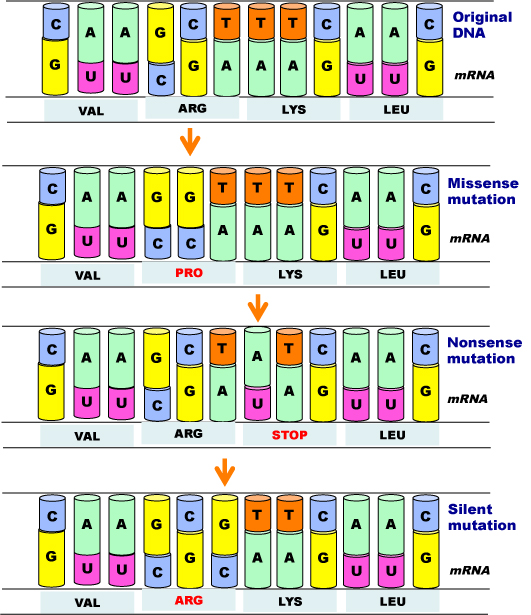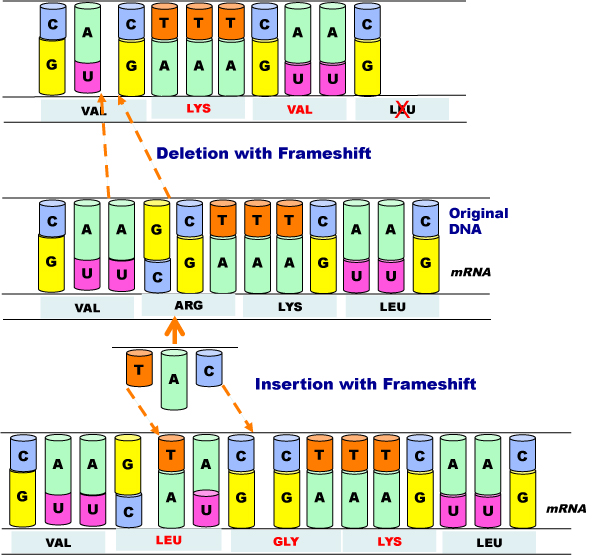| << Chapter < Page | Chapter >> Page > |


The changes to the DNA can occur on a base-by-base basis. However, it also is common for some DNA segments to cause changes or mutations as a group. These are known as a transposable element or Transposon . This occurs both as Chromosomal Rearrangement on the same chromosome or as Chromosomal Translocation where the genetic material is exchanged between non-homologous chromosomes. Transposons tend to affect the coding in different ways than point mutations. They can affect gene expression in a number of ways.
A common gene element mutation is Gene Duplication where additional copies of a gene are inserted into the sequence during the replication process. The gene-repeats produced by this process can lead to additional expression of the gene which produces more of the protein in the body. Depending on the circumstance this may be beneficial or it may cause disease. It does not have to be the entire gene that duplicates. Sometimes only specific sequences within the gene are involved in the duplication. Huntington's disease is caused by a repeating section of the HTT gene. This section of the gene appears prone to duplication, at least in some individuals. When the number of repeats of this segment hits a threshold the Huntingtin protein it produces is altered (misshapen) enough that it no longer functions properly.
Gene duplication also plays an important role in evolution. From an evolutionary perspective there can be an advantage to generating additional copies of a functioning gene. The additional copies provide raw material for modification while leaving other unchanged copies of the gene to produce the original protein necessary to carry out the normal physiological processes. Without extra copies this would not be possible and every new protein would have to evolve from scratch rather than from modification of an existing functional protein.
Another way transposons can affect outcomes is by changing gene expression that is controlled by specific promoters and inhibitors. When a transposon relocates it can change the relationship between the genes it carries and their promoters or inhibitors. Depending on where the transposon moves it may make previously inactive genes active or active genes inactive. The transposon also may have an effect on surrounding genes. If it inserts between an active gene and its promoter it may inactivate that gene. Additionally, if a transposon inserts at an intron/exon splicing boundary it can change the splicing characteristics and alter the protein variants produced.
DNA stores the information necessary for instructing the cell to perform all of its functions. Cells use the genetic code stored within DNA to build proteins, which ultimately determine the structure and function of the cell. This genetic code lies in the particular sequence of nucleotides that make up each gene along the DNA molecule. To “read” this code, the cell must perform two sequential steps. In the first step, transcription , the DNA code is converted into a RNA code. A molecule of messenger RNA that is complementary to a specific gene is synthesized in a process similar to DNA replication. The molecule of mRNA provides the code to synthesize a protein. In the process of translation , the mRNA attaches to a ribosome. Next, tRNA molecules shuttle the appropriate amino acids to the ribosome, one-by-one, coded by sequential triplet codons on the mRNA, until the protein is fully synthesized. When completed, the mRNA detaches from the ribosome, and the protein is released. Because the same codon is associated with the same amino acid in virtually all species a universal Genetic Code can be used to determine the amino acid sequence from any mRNA molecule. While each codon is associated with a single amino acid, the reverse is not true. Most amino acids have redundancy , meaning they are coded for by more than one codon. Typically, multiple ribosomes attach to a single mRNA molecule at once such that multiple proteins can be manufactured from the mRNA concurrently.
Watch this video to learn about ribosomes. The ribosome binds to the mRNA molecule to start translation of its code into a protein. What happens to the small and large ribosomal subunits at the end of translation?
They separate and move and are free to join translation of other segments of mRNA.

Notification Switch
Would you like to follow the 'Ucd bis2a intro to biology v1.2' conversation and receive update notifications?